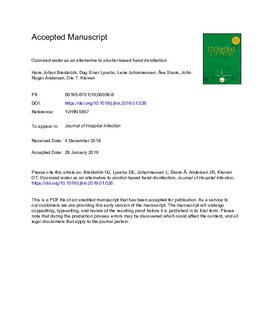| dc.contributor.author | Breidablik, Hans Johan | |
| dc.contributor.author | Lysebo, Dag Einar | |
| dc.contributor.author | Johannessen, Lene | |
| dc.contributor.author | Skare, Åse | |
| dc.contributor.author | Andersen, John Roger | |
| dc.contributor.author | Kleiven, Ole Tormod | |
| dc.date.accessioned | 2019-03-21T11:56:54Z | |
| dc.date.available | 2019-03-21T11:56:54Z | |
| dc.date.created | 2019-02-07T15:55:17Z | |
| dc.date.issued | 2019 | |
| dc.identifier.citation | Breidablik, H. J., Lysebo, D. E., Johannessen, L., Skare, Å., Andersen, J. R., & Kleiven, O. T. (2019). Ozonized water as an alternative to alcohol-based hand disinfection. Journal of Hospital Infection. | en_US |
| dc.identifier.issn | 0195-6701 | |
| dc.identifier.uri | http://hdl.handle.net/11250/2591065 | |
| dc.description | Author's accepted manuscript (post-print). | en_US |
| dc.description | Available: 2020-02-05. | |
| dc.description.abstract | Background
Hand hygiene plays a vital role in the prevention of transmission of micro-organisms. Ozone (O3) is a highly reactive gas with a broad spectrum of antimicrobial effects on bacteria, viruses, and protozoa. It can easily be produced locally in small generators, and dissolved in tap water, and quickly transmits into ordinary O2 in the surrounding air.
Aim
To compare ozonized tap water and alcohol rub in decontamination of bacterially contaminated hands.
Methods
A cross-over study among 30 nursing students. Hands were artificially contaminated with Escherichia coli (ATCC 25922), then sanitized with ozonized tap water (0.8 or 4 ppm) or 3 mL standard alcohol-based rub (Antibac 85%). The transient microbes from fingers were cultivated and colony-forming units (cfu)/mL were counted. The test procedure was modified from European Standard EN 1500:2013.
Findings
All contaminated hands before disinfection showed cfu >30,000/mL. The mean (SD) bacterial counts in (cfu/mL) on both hands combined were 1017 (1391) after using ozonized water, and 2337 (4664) after alcohol hand disinfection. The median (range) values were 500 (0–6700) and 250 (0–16,000) respectively (non-significant difference). Twenty per cent of participants reported adverse skin effects (burning/dryness) from alcohol disinfection compared with no adverse sensations with ozone.
Conclusion
Ozonized tap water is an effective decontaminant of E. coli, and it could be an alternative to traditional alcohol-fluid hand disinfectants both in healthcare institutions and public places. Ozonized water may be especially valuable for individuals with skin problems. | en_US |
| dc.language.iso | eng | en_US |
| dc.publisher | Elsevier | en_US |
| dc.rights | Attribution-NonCommercial-NoDerivatives 4.0 Internasjonal | * |
| dc.rights.uri | http://creativecommons.org/licenses/by-nc-nd/4.0/deed.no | * |
| dc.subject | ozone | en_US |
| dc.subject | alcohol rub | en_US |
| dc.subject | hand disinfection | en_US |
| dc.subject | e. coli | en_US |
| dc.title | Ozonized water as an alternative to alcohol-based hand disinfection | en_US |
| dc.type | Journal article | en_US |
| dc.type | Peer reviewed | en_US |
| dc.description.version | acceptedVersion | en_US |
| dc.subject.nsi | VDP::Medisinske Fag: 700::Klinisk medisinske fag: 750::Infeksjonsmedisin: 776 | nb_NO |
| dc.source.journal | Journal of Hospital Infection | en_US |
| dc.identifier.doi | 10.1016/j.jhin.2019.01.026 | |
| dc.identifier.cristin | 1674635 | |
| cristin.unitcode | 203,11,1,0 | |
| cristin.unitname | Institutt for helse- og omsorgsvitskap | |
| cristin.ispublished | true | |
| cristin.fulltext | postprint | |
| cristin.qualitycode | 1 | |

